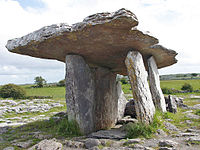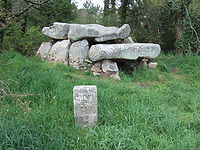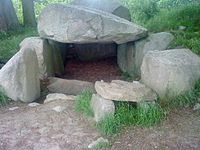Dolmen: Difference between revisions
GoingBatty (talk | contribs) clean up, typos fixed: etc → etc. using AWB (7351) |
May09dream (talk | contribs) |
||
| Line 95: | Line 95: | ||
* [http://www.archeologiasarda.com Some monuments with QTVR panoramic views in Archeologia Sarda] |
* [http://www.archeologiasarda.com Some monuments with QTVR panoramic views in Archeologia Sarda] |
||
* [http://bruno.marc1.free.fr/dolmen Dolmens, Menhirs & Stones-Circles in the South of France] in French and English |
* [http://bruno.marc1.free.fr/dolmen Dolmens, Menhirs & Stones-Circles in the South of France] in French and English |
||
* [http://www.megalithicireland.com/index.html Dolmens in Ireland - Megalithic Ireland] |
|||
* [http://members.home.nl/jbmeijer/hunepic.htm Pictures of ''Hunebedden'' in the Netherlands] {{nl}} |
* [http://members.home.nl/jbmeijer/hunepic.htm Pictures of ''Hunebedden'' in the Netherlands] {{nl}} |
||
* [http://www.burrenforts.ie/mainj/dolmen.htm Poulnabrone Dolmen in the Burren, County Clare, Ireland] |
* [http://www.burrenforts.ie/mainj/dolmen.htm Poulnabrone Dolmen in the Burren, County Clare, Ireland] |
||
Revision as of 00:38, 27 November 2010



A dolmen—also known as a portal tomb, portal grave, cromlech (Welsh), anta (Portuguese), Hünengrab/Hünenbett (German), Adamra (Abkhazian), Ispun (Circassian), Hunebed (Dutch), dyss (Swedish), goindol (Korean) or quoit—is a type of single-chamber megalithic tomb, usually consisting of three or more upright stones supporting a large flat horizontal capstone (table). Most date from the early Neolithic period (4000 to 3000 BCE). Dolmens were usually covered with earth or smaller stones to form a barrow, though in many cases that covering has weathered away, leaving only the stone "skeleton" of the burial mound intact.
Etymology
"Dolmen" originates from the expression taol maen, which means "stone table" in Breton, and was first used archaeologically in Théophile Corret de la Tour d'Auvergne's Origines gauloises.[1] The etymology of the German Hünenbett or Hünengrab and Dutch Hunebed all evoke the image of giants building the structures. Of other Celtic languages, "cromlech" derives from Welsh and "quoit" is commonly used in Cornwall. Anta is the term used in Portugal, and dös or dyss in Sweden.
Dolmen sites
Europe
Megalithic tombs are found from the Baltic Sea and North Sea coasts south to Spain and Portugal. Hunebedden are chamber tombs similar to dolmens and date to the middle Neolithic (Funnelbeaker culture, 4th millennium BC). They consist of a kerb surrounding an oval mound which covered a rectangular chamber of stones with the entrance on one of the long sides. Some have a more complex layout and include an entrance passage giving them a T-shape. It has been suggested that this means they are related to the passage graves found in Denmark and elsewhere.
Dolmen sites fringe the Irish Sea and are found in south-east Ireland, Wales, Devon and Cornwall. In Ireland, however, dolmens are more to be found on the west coast, particularly in the Burren and Connemara, where some of the better-known examples, such as Poulnabrone dolmen, are to be found. Examples have also been found in northern Ireland where they may have co-existed with the court cairn tombs. It is thought that the dolmens themselves evolved from a simpler cist burial method.
A great many examples can also be found on the Channel Islands of Jersey and Guernsey, such as La Pouquelaye de Faldouet, La Sergenté and La Hougue des Géonnais. The term Houge is derived from the Old Norse word haugr meaning a mound or barrow. The most famous of these sites is La Hougue Bie, a 6,000 year old neolithic site that sits inside a large mound; later a chapel was built on the top of the mound.[2]
Amongst the vast Neolithic collections of the Carnac stones in Brittany, France, several dozen dolmens are found. And all around the country, several dolmens still stand, such as the ones of Passebonneau and des Gorces near Saint-Benoît-du-Sault.
Various menhirs and dolmens are located around the Mediterranean islands of Malta and Gozo. Pottery uncovered in these structures allowed the attribution of the monuments to the Tarxien cemetery culture of the Early Bronze Age.[3] This later culture is not to be confused with the Neolithic inhabitants of Malta, who built the Tarxien Temples circa 3100 BCE.
In France, important megalithic zones are situated in Brittany, Vendée, Quercy and in the south of France (Languedoc, Rouergue and Corsica). More than 10,000 dolmens and menhirs cover a large part of the country (west and south). Importants menhirs alignments in Brittany (Carnac's alignments count more than 1,000 menhirs)
In Spain dolmens can be found in Galicia (such as Axeitos, pictured below), Basque Country and Navarre (like the Sorgin Etxea) and the basque name for theme is Trikuharri or Jentiletxe, Catalonia (like Romanyà de la Selva or Creu d'en Cobertella), Andalusia (like the Cueva de Menga) and Extremadura (like "Dolmen de Lácara").
Dolmens can be found across Portugal, from simple ones [1] to the more complex examples of megalithic architecture, such as the Almendres Cromlech or the Anta Grande do Zambujeiro.
In Mecklenburg and Pomerania/Pomorze in (Germany) and (Poland), Drenthe (Netherlands), large numbers of these graves were disturbed when harbours, towns, and cities were built. The boulders were used in construction and road building. There are still many thousands left today in Europe.
In Italy some dolmens can be found in the south (Puglia) and in Sardinia.
In Turkey,there are some dolmens in the Regions of Lalapasa and Suloglu in the Province of Edirne and the Regions of KOfcaz, Kirklareli and Demirkoy in the Province of Kirklareli, in the Eastern Thrace. They have been studied by Prof. Dr. Engin Beksaç, since 2004. And also, some of so-called monuments are in the different regions of Anatolia, in Turkey.
There are interesting dolmens in the regions related to the Sakar and Rodope and Stradja Mountains in Bulgaria.
The largest dolmen in Europe is the Brownshill Dolmen in County Carlow, Ireland. Its capstone weighs about 150 tonnes.[4]
Asia


Similar tombs can be found all over the world. Korea has many of the Asian dolmens, dating from the 1st millennium BC. The dolmen in Ganghwa is a northern-type, table-shaped dolmen where ancestral rites were held. It is the biggest stone of this kind in South Korea, measuring 2.6 by 7.1 by 5.5 metres. The number of dolmens in North and South Korea, approximately 30,000, is about 40% of the total number of dolmens in the world. Similar dolmens can be found outside of Korea, in Manchuria, Shandong, and Kyushu.
There are also dolmens in Kerala, South India, about 7 km from Marayoor near the small village of Pius Nagar, also known as Alinchuvad. These dolmens are set in clusters of two to five dolmens obviously for the burial of a family. There are hundreds of such dolmen clusters in the area. Apart from overground dolmens, underground burial chambers built with dressed stone slabs have also been discovered in Marayoor. All these dolmens are made from heavy granite slabs, mined using primitive technology. This was a burial ground for several centuries for a noble tribal dynasty known as Adi Cheras, the royal family, which rose as a paramount power in South India in the First Century CE. The Adi Chera tribe traded with the Egyptian and Roman empires of the time. Most of the overground dolmens found in Alinchuvad were made before the Iron Age since no tools were used to dress the granite slabs. On a nearby hill, granite dolmens made, using tools, are also seen. One is underground and the other is overground. The overground dolmen of this type was not used for burial. The length of the dolmens range from 11 ft to 4 ft. There are scores of 4 ft versions of underground type. They had two earthenware pots, one containing the ornaments and weapons of the individual and the other contained the cremation remains. Such underground dolmens are located in various places, like Chelamala,in Ernakulam District, Mattathipara, Muniyara, Panapilavu, etc. in the district of Idukki in Kerala State, where Marayoor also is located. It appears that the tribe continued to use this burial practice until the tribe was destroyed in the beginning of third century CE.
Middle East
Dolmens are also found in Israel, Syria and Jordan. Numerous large dolmens can be viewed in the Israeli National park at Gamla.
There are many examples of flint dolmens in the historical villages of Johfiyeh and Natifah in northern Jordan.
Eurasia
Over 3,000 dolmens and other structures can be found in the North-Western Caucasus region in Russia, where more and more dolmens are discovered in the mountains each year.
Dolmens in fiction
Dolmens have been used in fiction which supplied several proposals for the purpose of these structures.
Here is a list of works of fiction featuring dolmens:
- Hype: The Time Quest (PC action-adventure game, 1999) - The dolmen played an important part of the story as it was the only way for the game's protagonist to enter the Lost City which was "situated outside of time".
- Outcry (PC adventure game, 2008, also known as Sublustrum) - The dolmens are an integral part of the plot. It is proposed in the game that dolmens were used by a long gone civilization to "separate" ones consciousness from ones body, allowing that person to enter a parallel universe called "The Shimmering World". This was supposedly done by subjecting the person to infra sounds inside the dolmen (which serves as an explanation as to why dolmens were often built in areas with high seismic activity - to create infra sounds from both wind and earthquakes) and the effects of a plant known as Albertia indorum. The story revolves around a Russian scientist in the early 20th century who creates a machine capable of replicating this function.
See also
- Megalithic art
- Gochang, Hwasun and Ganghwa Dolmen Sites
- Menhir
- Megalith
- Neolithic Europe
- List of megalithic sites
- Irish Megalithic Tombs
- Stone circle
References
- ^ Corret de la Tour d'Auvergne, Origines gauloises. Celles des plus anciens peuples de l'Europe puisées dans leur vraie source ou recherche sur la langue, l'origine et les antiquités des Celto-bretons de l'Armorique, pour servir à l'histoire ancienne et moderne de ce peuple et à celle des Français, 1792-97.
- ^ The Scandinavian Contribution in Normandy
- ^ Journal of European Archaeology (JEA), 5 (1997); Emilia Pásztor and Curt Roslund: Orientation of Maltese dolmens.
- ^ Weir, A (1980). Early Ireland. A Field Guide. Belfast: Blackstaff Press. p. 101.
Sources
- Trifonov, V., 2006. Russia's megaliths: unearthing the lost prehistoric tombs of Caucasian warlords in the Zhane valley. St.Petersburg: The Institute for Study of Material Culture History, Russian Academy of Sciences. Available from [2]
- Kudin, M., 2001. Dolmeni i ritual. Dolmen Path - Russian Megaliths. Available from [3]
- Knight, Peter. Ancient Stones of Dorset, 1996.
External links
- Dolmens of Dorset
- Some monuments with QTVR panoramic views in Archeologia Sarda
- Dolmens, Menhirs & Stones-Circles in the South of France in French and English
- Dolmens in Ireland - Megalithic Ireland
- Pictures of Hunebedden in the Netherlands Template:Nl
- Poulnabrone Dolmen in the Burren, County Clare, Ireland
- Template:PDFlink on UNESCO's World Heritage List.
- Dolmen Pictures by Robert Triest.
- Russian Megaliths
- Jersey Heritage Trust
- Legananny Dolmen, Ireland
- World heritage site of dolmen in Korea
- The Megalithic Portal and Megalith Map







